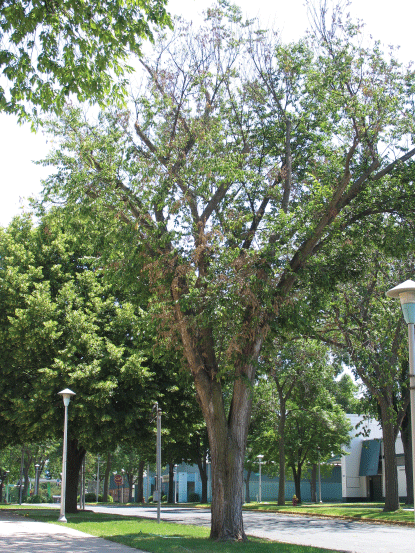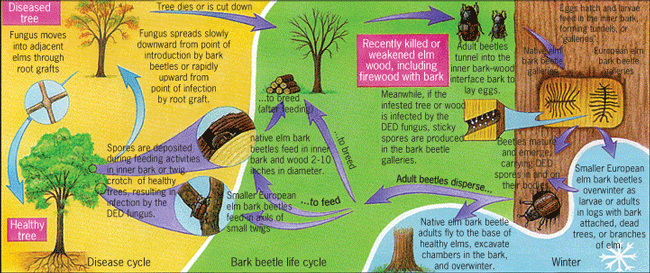The Dutch elm disease (DED) pathogen infects the vascular tissues of elms and disrupts their water transport, causing wilt symptoms and tree death (Fig. 1). DED devastated American elms across the eastern United States in the mid-1900s. Despite the huge numbers killed by DED, elms remain important in our forests and cities, and the use of disease-tolerant elms in our landscapes is becoming more feasible.

History
The disease first appeared in northwest Europe in the early 1900s, causing the death of European elms, and was given the name Dutch elm disease. In the 1920s, the causal fungal pathogen (Ophiostoma ulmi) and the smaller European elm bark beetle were introduced to North America on imported logs. The disease spread across Europe, southwest Asia, and North America in a pandemic of elm death. By the 1940s, the rate of elm mortality declined in Europe. However, in the 1970s, there was a sharp increase in the incidence of DED. Simultaneously, in North America, elms began dying in greater numbers, and it was recognized by the late 1970s that there was a second, more aggressive fungal species, O. novo-ulmi, that was causing the increased mortality. Molecular studies later revealed that there were separate North American and European races of O. novo-ulmi, and that hybridization between O. ulmi and O. novo-ulmi had resulted in changes in the fungal population. A related fungus, O. himal-ulmi, is present in the Himalayas, where it causes little damage to native elms, but appears to be highly virulent on European and American elms. Both O. ulmi and the North American strain of O. novo-ulmi were recently discovered in Japan, but without record of wilting trees or visible disease. It is quite likely that O. ulmi and O. novo-ulmi are native to Asia, particularly because Asian elms have a much higher tolerance to the pathogens, but this has not been confirmed. However, it is known that there are multiple species and subspecies of Ophiostoma that cause DED, and these fungi hybridize and exchange genetic material.
Overall, DED is a complex of multiple pathogens acting on many hosts that grow in different habitats. This article will focus primarily on the biology of DED and opportunities for recovery of the American elm in North America.
Disease cycle
The American elm (Ulmus americana) is very highly susceptible to DED, and no native elms within North America are immune. Other North American elms (winged elm, September elm, slippery or red elm, rock elm, and cedar elm) range from susceptible to somewhat tolerant. European and Asiatic elms are less susceptible than the American elm. DED is considered to now be present throughout the entire natural range of the American elm.
The disease cycle of DED is linked to the life cycles of elm bark beetles, including the smaller European elm bark beetle (Scolytus multistriatus) and the native elm bark beetle (Hylurgopinus rufipes) [Fig. 2]. The more recently introduced banded elm bark beetle (S. schevyrewi) can also carry spores of Ophiostoma. Adult elm bark beetles are attracted to stressed, dying, or dead elms to complete the breeding stage of their life cycle. The adult beetles tunnel in and lay their eggs in the inner bark; then, the eggs hatch and the larvae feed in the inner bark and cambium (the layer of cells between the phloem and xylem of most vascular plants), leaving diagnostic patterns of galleries. If a beetle-attacked tree has DED, the fungus produces sticky spores in the beetle galleries. When the larvae mature and emerge from the trees as adults, they often carry spores in and on their bodies. Adult beetles then visit healthy trees, feed in twig crotches or branch inner bark, and introduce the fungus to severed vessels as they feed, thereby infecting the tree and perpetuating the cycle of disease. Once an elm tree is diseased, the pathogen moves through the vascular system of the tree and spreads to adjacent elms through connected roots.

The American elm is adapted to grow in a wide variety of soils and environments, including floodplains and uplands. It grows quickly and produces prolific seed at a young age. Despite the effects of DED, small-diameter elm trees are still common in fence rows and forests. The persistence of elms in the environment ensures the survival of the species, but it also enables the persistence of disease and vectors (pathogen-carrying agents) on the landscape. Outbreaks of DED occur when the elm population increases in the landscape and then comes under stress from drought or other factors, allowing elm bark beetle populations to build up and spread disease. The pathogen, however, does not need stressed trees to infect. In fact, it actually spreads faster within a tree when there is adequate moisture and the vessel elements have a large diameter and are open.
Potential for management of the disease
Management of DED should focus on breaking the disease cycle of the pathogen by management of the vectors, fungi, or host. Because of the strong relationship between the vectors and the spread of DED, sanitation to remove woody debris containing elm bark beetles can be quite successful in limiting the severity of outbreaks. Chemical control of the vectors with insecticides is used to a limited degree.
Spread of the fungus to adjacent trees through connected roots can be stopped by breaking the grafts or connections between trees, often with a vibratory plow. Certain fungicides injected properly into valuable elms can protect them from fungal spores that are carried by elm bark beetles. This protection can last up to 3 years. However, the treatment itself poses some risk to the ongoing health of the tree.
Managing the host to reduce the risk of disease is primarily accomplished by planting individual trees with tolerance to the disease. Injection of individual elms with a nonpathogenic strain of another fungus appears to provide temporary acquired resistance, but the utility of this treatment is limited.
Opportunities for recovery
For American elms, the ability to survive infection by DED is usually described as tolerance, rather than resistance, because surviving trees may be infected by the fungus, but are able to tolerate the infection and survive with minimal symptoms. The mechanism or mechanisms that control this tolerance are not yet fully understood, but may be related to the ability of the tree to isolate the pathogen by compartmentalizing it. Only a few putatively DED-tolerant pure American elm cultivars are commercially available, including Valley Forge, New Harmony, Princeton, Prairie Expedition, American Liberty, and Jefferson.
Large surviving American elms are occasionally found in the landscape. Some of these trees may have escaped infection by DED through luck or seclusion, but some may have innate characteristics that enable them to survive. Several research groups, including the Elm Recovery Project at the University of Guelph (Ontario, Canada), the Elm Selection Program at the University of Minnesota, and the U.S. Forest Service Northern Research Station, have collected scion wood (that is, the section of a woody plant, usually a stem or bud, which is attached to the stock in grafting) from promising “survivor elms” to test for DED tolerance. The current testing procedure takes many years, requiring the test elms to be grown past the stage of juvenile resistance before being challenged by the DED pathogen. Through this screening process, more varieties of DED-tolerant American elms should become available.
The American elm has a different number of chromosome copies than other elm species, which has complicated breeding programs that would cross the American elm with more tolerant elms of other species. However, recent research at the National Arboretum in Washington, DC, has revealed that the number of copies of chromosomes varies within the American elm population. Further research in this rapidly emerging field may yield new opportunities for elm breeding and DED tolerance.
Conclusions
Despite the ravages of DED, there is hope that the American elm may one day be restored to its former ecological niches. The use of traditional resistance breeding and new techniques for genetic manipulation may provide us with American elms that can survive, despite the disease, in cities and forests. Even now, cultivars of American elm are available for urban utilization and wild land restoration. Caution is advised, however, because there are very few available cultivars and the pathogen is highly adaptable. It is prudent to use the available tolerant elms in mixtures with other tree species.
See also: Breeding (plant); Coleoptera; Elm; Forest and forestry; Forest management; Forestry, Urban; Fungal virus; Fungi; Fungistat and fungicide; Genetically engineered plants; Invasion ecology; Plant growth; Plant pathology; Population ecology; Primary vascular system (plant); Reforestation; Tree; Tree diseases





